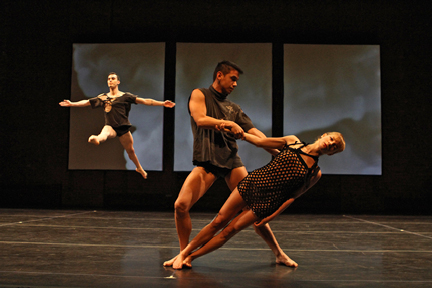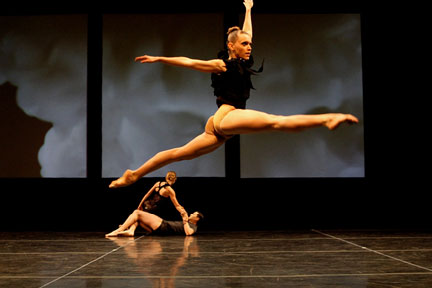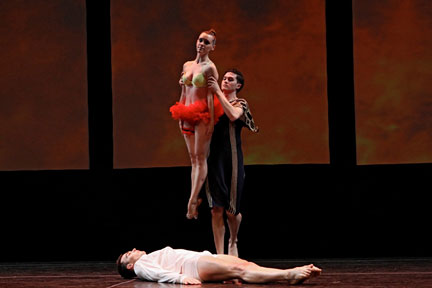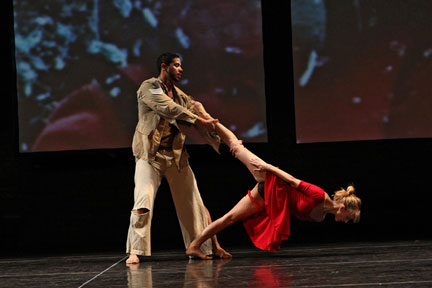Stephen Petronio Dance Company
Underland
Sunday April 10 – Evening
All Photos by Julie Lemberger

Stephen Petronio’s Underland opens with guest artist Reed Luplau hanging upside down about ten feet above the stage and descending a rope ladder like a spider. A triptych of screens cover the back of the stage and as the beautiful heartrending noise of Descent to Underland rings out, cloudy images are displayed. Petronio’s Underland was inspired by a collection of songs written and performed by Nick Cave. In the program notes, Petronio says that this dance is an attempt to locate a “place” beneath the surface.
Petronio has a unique voice when it comes to choreography and it’s nothing but a pleasure to witness his dancers at work. The movement is quick, challenging and unpredictable, all of it executed beautifully. Right out of the gate, the dance is dazzling even as the subject matter of the songs continually grows darker. We see high leaps, lots of cabrioles and big dramatic grand ronde des jambes. Some of the men perform a recurring movement in which the back leg folds and unfolds rapidly, as if the dancer is shaking something loose. Legs and arms are fully unfurled. The movement is big, sharp and expressive. I am impressed by the dancers’ ability to be moving at full tilt and then suddenly halt the momentum and melt into something static and softer. I often get the feeling that the choreography contains hidden references. Early in the piece, a few sequences end with the dancer standing straight in fifth position with one arm en haut, as if ready to perform a barre exercise.

In the program, Petronio stated that he considered the dance to be non-narrative, but I found it hard to listen to the emotion of these songs and the stories that they tell without imagining a narrative in the choreography.
During the first songs, the dancers are dressed in torn black and gray costumes. Their movement, along with the visuals on the screen, grow slowly darker in tone. The piece turns a corner about halfway through, during the song The Carny, when the men emerge in white and the women in red tutus. The movement becomes a mechanical waltz.

For The Weeping Song, the company emerge dressed as GIs,. Their costumes are torn and it left me feeling as if they’d been through battle. Andy Warhol style repetitive images of mushroom clouds appear on the screens. The images multiply and toward the end, when the original image returns, we see the image of a dollar bill inserted inside the cloud. The dancers dramatize the ravages of war and the piece resolves with them marching barefoot. It seems as if this is the first moment in the evening when the action settles down and an eerie kind of quiet descends.
Four dancers come downstage and cling to one another in The Ship Song. They are expressing fraternity and love. I felt as if they were preparing to move, or maybe they were being relocated. Perhaps one of them was embarking on a journey of his or her own. Throughout the piece, the dancers don’t travel far from their opening spots on stage. Their physical closeness reminds me of the closeness of a family.

Emotional fireworks ignite to accompany the song Stagger Lee. Natalie Mackessy explodes on to the stage in a crimson red dress. She seems to be moving impossibly fast and she is put through a course of acrobatic lifts. I wondered if she was representing violence for the sake of violence. Even amongst this selection of dark songs, the music and lyrics of Stagger Lee are especially ferocious and gritty. As the emotion runs higher and higher, the GIs return, this time with bits of red fabric hanging from inside their uniforms. Have they been bloodied? Are their bodies on fire, figuratively or literally?
This dance moves into The Mercy Seat, a heart wrenching song sung from the point of view of an innocent man being placed in the electric chair. A clock is projected on the center screen, ticking down the minutes to the hour of execution. But there is some redemption to be found in Death is Not the End, where the company returns to the stage dressed in white, and the dancing resolves into something more lyrical and peaceful.
As bows were taken and a standing ovation rose up, loud cheers went up for dancer Shila Tirabassi. Petronio took up a microphone and announced that after ten years with the company Ms. Tirabassi had just given her last performance. This saddened me, because the first time that I’d ever seen this company years earlier, she’d been the featured dancer in the very first piece, so I have always associated her as being one of the quintessential Petronio dancers. She’s provided me with so many hours of amazing dance.
Petronio ended the night by telling the audience, “Without art, we’re nothing more than a bunch of dumb monkeys who would kill each other for a crust of bread.”




